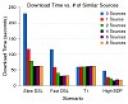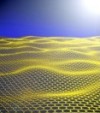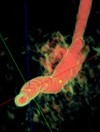Spider silk is “pound for pound” stronger than steel and has a greater elasticity than rubber. Such properties would make it a rather useful material for a large variety of medical and engineering applications if only it could be made in large enough quantities and with a useful thickness and consistency.
Thomas Scheibel at the Technical University of Munich has now taken a step towards understanding the spider’s secret with a view to creating an artificial spinneret for producing unlimited quantities of spider silk. Writing in in Angewandte, the team explain how they have discovered that the interaction between the hydrophilic and lipophilic properties of the silk proteins plays an important role in the spinning process.
Fundamentally, the spinning of spider silk represents a phase change from a solution into a solid thread. The silk used by orb weaver spiders to spin the edges and spokes of their webs and to make a quick escape when attacked is composed of two different proteins. The Munich team has now successfully used genetic engineering to produce one of the spider silk proteins of the European garden spider (Araneus daidematus).
While purifying the protein by dialysis, the researchers observed the separation of two different fluid phases. Whereas one phase consisted of protein dimers, the second consisted of oligomers. After adding potassium phosphate, a natural initiator of silk aggregation, the liquid could be pulled into threads. “It is clearly not a structural change in the protein, but rather the degree of oligomerization that is crucial for thread formation,” concludes Scheibel.
 Anyone who has dared to download, a large file using the Bit Torrent system in which chunks of the file are pulled from other BT users in a form of distributed file sharing will know how slow (and sometimes how fast) the method can be. Although much of the BT system is exploited to share pirated movies and music it has a serious, legitimate side that also allows scientists, engineers and programmers to share the burden of huge database and ISO image downloads. Now, thousands of US tax dollars (in the form of an NSF CAREER grant) have been spent on improving on the Bit Torrent system.
Anyone who has dared to download, a large file using the Bit Torrent system in which chunks of the file are pulled from other BT users in a form of distributed file sharing will know how slow (and sometimes how fast) the method can be. Although much of the BT system is exploited to share pirated movies and music it has a serious, legitimate side that also allows scientists, engineers and programmers to share the burden of huge database and ISO image downloads. Now, thousands of US tax dollars (in the form of an NSF CAREER grant) have been spent on improving on the Bit Torrent system. Cutting out the French fries, burgers, chips, candy, beer, soda, and other delicious yet largely non-nutritious food and drink from your diet is generally a good idea. One of the reasons, health experts suspect, is that somehow a reduced-calorie diet leads to a longer life. Now, researchers at Imperial College London have looked at a dog’s life and discovered why dietary restriction could lead to a longer life.
Cutting out the French fries, burgers, chips, candy, beer, soda, and other delicious yet largely non-nutritious food and drink from your diet is generally a good idea. One of the reasons, health experts suspect, is that somehow a reduced-calorie diet leads to a longer life. Now, researchers at Imperial College London have looked at a dog’s life and discovered why dietary restriction could lead to a longer life. Graphene recently hit the headlines as a potential replacement for silicon in a future world of molecular computing. However, until silicon technology has run its course and arrays of millions of transistors can be carved at will from this material, scientists will have to be content with investigating its properties and devising novel uses.
Graphene recently hit the headlines as a potential replacement for silicon in a future world of molecular computing. However, until silicon technology has run its course and arrays of millions of transistors can be carved at will from this material, scientists will have to be content with investigating its properties and devising novel uses. Do you workout hard? Is “no pain, no gain” your exercise ethos? Do you feel like you are not getting the fitness results you expect? Your brain could be to blame.
Do you workout hard? Is “no pain, no gain” your exercise ethos? Do you feel like you are not getting the fitness results you expect? Your brain could be to blame. Think of MRI and most people think of medical scanning, the kind of analytical tool that can slice through your brain or other organs, virtually speaking, and produce a three-dimensiona view of your innards. But researchers in Canada are putting the magnetic in magnetic resonance imaging to a different. They hope to use it to control tiny robot devices that can be guided through blood vessels in an application reminiscent of 1960s sci-fi movie Fantastic Voyage.
Think of MRI and most people think of medical scanning, the kind of analytical tool that can slice through your brain or other organs, virtually speaking, and produce a three-dimensiona view of your innards. But researchers in Canada are putting the magnetic in magnetic resonance imaging to a different. They hope to use it to control tiny robot devices that can be guided through blood vessels in an application reminiscent of 1960s sci-fi movie Fantastic Voyage. Yesterday, we ran a video showing you a
Yesterday, we ran a video showing you a